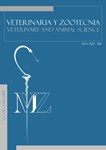Autores/as
Resumen
RESUMEN El tercer párpado es una estructura formada por tres componentes: glandular, conjuntival y cartilaginoso. Es responsable de la producción del 30-50% de la porción acuosa de la película precorneal. El prolapso de la glándula u “ojo cereza” es el desorden primario más común en el tercer párpado. El tratamiento es exclusivamente quirúrgico, yendo desde la exéresis de la glándula hasta su reposicionamiento, siendo la recidiva frecuente. El objetivo de esta comunicación fue establecer la prevalencia según raza, edad y presentación (unilateral/bilateral) del prolapso de la glándula del tercer párpado en caninos atendidos en el departamento de cirugía del Hospital Veterinario “Diego Villegas Toro” de la Facultad de Ciencias Agropecuarias de la Universidad de Caldas y en una clínica veterinaria privada de la ciudad entre febrero y mayo/2009. El Médico Veterinario de pequeños animales deberá estar preparado para resolver este tipo de consultas, teniendo en cuenta que el manejo de los problemas en los tejidos anexos, repercute sobre estructuras más sensibles, como la córnea.
Citas
Baungarten, L.B.; Eurides, D.; Busnardo, C.A.; Guimarães, E.C.; Alves, L.B.; Da Silva, L.A.F.; Daleck, C.R.; De Souza, L.A.; De Oliveira, B.J.N.A.; Golçalves, G.F. Avaliação da produção de lágrima em cães sem raçã definida após a exérese da glândula da terceira palpebra – estudo experimental. Revista Ceres, v.55, n.4, p.293- 296, 2008.
Brito, F.L.C.; Silva, V.A.; Maia, F.C.L.; Pereira, J.R.; Laus, J.L. Microalterations in the third eyelid gland of dogs with keratoconjuntivitis sicca secondary to distemper. Arquivo Brassileiro de Medicina Veterinaria e Zootecnia, v.59, n.2, p.340-344, 2007.
Blogg, JR. Diseases of the Eyelids. In: The Eye in Veterinary Practice: Extraocular Disease. Philadelphia: Saunders W. B; 1980: p. 342.
Cabral, V.P.; Laus, J.L.; Zaidan, M.L.; Pereira, G.T.; Talieri, I.C.; Monteiro, E.R.; Mamede, F.V. Canine lacrimal and third eyelid superficial gland’s macroscopic and morphometric characteristics (Canis familiares; LINNAEUS, 1758). Ciência Rural, v.35, n.2, p.391-397, 2005.
Cabral, V.P.; Watanabe, E.; Tostes, R.A.; Simonelli, S.M.; Laus, J.L. Protrusão da glândula da terceira pálpebra em cães. Proposta de um modelo experimental. Ciência Rural, v.38, n.7, p.1920- 1924, 2008.
Gelatt, KN. Manual de oftalmologia veterinária. São Paulo: Manole, 2003. 280p
Gross, SL. Effectiveness of a Modification of the Blogg technique for Replacing the Prolapsed Gland of the Third Eyelid. Proc. Am. Coll. Vet. Ophthalmol; vol. 14: p. 38 – 42, 1983.
Herrera, D. Enfermedades de los párpados. In: Herrera Daniel. Oftalmología clínica en animales de compañía. 1.Ed. Buenos Aires, Argentina: Ed. Intermédica, 2007. 104p.
Kaswan, RL; Martin, CL. Surgical correction of thirdeyelid prolapse in dogs. Journal of AmericanVeterinary Medical Association. vol.186, n.1:p.83, 1985.
Lackner, P.A. Techniques for Surgical Correction ofAdnexal Disease. Clinical Techniques in SmallAnimal Practice, v.16, n.1, p.40-50, 2001. W.B.Saunders Company.
Mazzucchelli, S.; Vaillant, M.D.; We’verberg, F.;Arnold-Tavernier, H.; Honegger, N.; Payen, G.;Vanore, M.; Liscoet, L.; Thomas, O.; Clerc, B.;.Chahory, S. Nictitans gland prolapse in dogs: aretrospective study of 155 cases (2001-2008).Abstracts: Annual Meeting of the EuropeanCollege of Veterinary Ophthalmologists/European Society of Veterinary Ophthalmologists,Copenhagen, Denmark, June 3-7, 2009.Veterinary Ophthalmology, American Collegeof Veterinary Ophthalmologists (ACVO), v.12,n.6, p.386-389, 2009.
Moore, CP; Frappier, BL; Linton, LL. Effects of twosurgical replacement techniques on excretory ducts of normal canine third eyelid glands.Proceedings of the American College ofVeterinary Ophthalmologists; vol. 25: p. 25,1994.
Morgan, RV; Duddy, JM; McClurg, K. Prolapse of thegland of the third eyelid in dogs: a retorspectivestudy of 89 cases (1980 to 1990). Journal ofthe American Animal Hospital Association,vol.29, n.1: p.56–60, 1993.
Peixoto, R.V.; Galera, P.D. Revisão de literatura:técnicas cirúrgicas para redução da protrusão daglândula da terceira pálpebra em cães. MedvepRevista Cientifica de Medicina VeterináriaPequenos Animais e Animais de Estimação,v.7, n.22, p.319-322, 2009.
Plummer, C.E.; Källberg, M.E.; Gelatt, K.N.; Gelatt,J.P.; Barrie, K.P.; Brooks, D.E. Intranictitanstacking for replacement of prolapsed glandof the third eyelid in dogs. Veterinary Ophthalmology, American College ofVeterinary Ophthalmologists (ACVO), v.11, n.4,p.228-233, 2008.
Slatter, D. Fundamentos de oftalmologiaveterinária. São Paulo: Roca, 2005. 686p.
Stanley, RG; Kaswan, RL. Modification of theOrbital Rim Anchorage Method for SurgicalReplacement of the Gland the third Eyelidsin Dogs. Journal of American Veterinary Medical Association, vol. 205, p. 1412 – 414,1994.
Umeda, Y.; Nakamura, S.; Fujiki, K.; Toshida,H.; Saito, A.; Murakami, A. Abstract No.:087 Globet cell MUC5AC MRNA in caninenictitanting membrane (2009). Abstracts: 40th Annual Meeting of the American Collegeof Veterinary Ophthalmologist, Chicago,IL, USA November 4-7, 2009. VeterinaryOphthalmology, American College of Veterinary Ophthalmologists (ACVO), v.12, n.6,p.390-409, 2009.
Wolf, ED. Abstract No.: 070 Cartilage reversal: atechnique for correction of everted nictitans.Abstracts: 40th Annual Meeting of the AmericanCollege of Veterinary Ophthalmologist,Chicago, IL, USA November 4-7, 2009.Veterinary Ophthalmology, American Collegeof Veterinary Ophthalmologists (ACVO), v.12,n.6, p.390-409, 2009.

 PDF
PDF
 FLIP
FLIP










